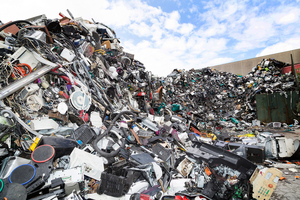The holiday are right around the corner and people are shopping for their loved ones. One of the most popular Christmas gifts will be electronic products, but as people receive their new smartphones, TVs and computers, ‘old’ models will undoubtedly contribute towards the growing problem that is e-waste (electronic waste).
In 2019 alone, there were 53.6 million tonnes (Mt) of electronic waste globally according to statistics from the United Nations (UN). This is equivalent to the weight of 350 large cruise ships.

Interested in electronic waste, Clear it Waste utilised e-waste data from the Global E-Waste Statistics Partnership and household composition data from the United Nations to calculate, out of 39 European countries, who produces the most e-waste on average per household each year.
Which European country produces the most e-waste per household?
Clear it waste found that Norwegians are the biggest culprits in Europe when it comes to e-waste, as the average amount generated per household is 57kg annually. That is the same weight as six small business printers.

The UK is in second position British households are producing 55kg of e-waste per year. The e-waste per household in UK is the equivalent weight of twenty 22-inch computer monitors.
Considering that there are 27.8 million households in the UK, the collective e-waste in the country could potentially be 1,529,000,000kg the equivalent weight of 1,174,347 city cars.
Irish households produce an average of 52.4kg of e-waste every year and are in third spot. Irish household e-waste is comparable to the weight of five adult bicycles.
In fourth place is Switzerland the Swiss generate 51.5kg of e-waste per household. With 3.8 million private households in Switzerland, the overall household e-waste in the country could equate to 195,700,000kg approximately the same weight as 11 submarines.
Other European countries whose households produce more than 45kg of e-waste include Spain (49.4kg), Netherlands (47.5kg), Cyprus (47kg), France (46.2kg) and Luxembourg (45.4kg), respectively ranking fifth, sixth, seventh, eighth and ninth.
On the other end of the scale, in 39th position is Moldova. Moldovans hold the crown of generating the least e-waste in Europe at an average of 11.6kg per household each year. The e-waste weight per household in Moldova is equivalent to the weight of nine empty 1.7 litre plastic kettles.
Clear it waste consulted energy specialists SaveOnEnergy for their top tips on how you can reduce e-waste this Christmas:
- Sell ‘old’ working electronics online
Many will undoubtedly get new electronic devices this Christmas. Instead of binning or letting the ‘old’ electronic devices be forgotten about in your cupboards until they no longer work properly, consider selling them online. There are a vast number of reputable online selling platforms and recycling websites which could pay you a handsome sum for the electronics that you don’t intend to use again.
- Repurpose old electronics
Just because you have been gifted the newest version of an electronic this year, your old device doesn’t have to become redundant. Think about how you can reuse it for some other purpose for instance, why not use your old smartphone as a GPS, music player or universal remote control. Overtime, repurposing old electronics could save you a fortune and reduce the harmful impact on our planet.
- Make eco-conscious decisions when gifting
Retailer offers and discounts in the run-up to Christmas can be very enticing but always ask yourself ‘does the person I want to gift this item to really need it’? This thought-process is especially important when considering electronic gift purchases because the ‘new’ model might not necessarily be better than the existing model. It may look and sound fancier, but if it doesn’t really improve the recipient’s experience by that much more, why buy it?
All figures in this research by Clear it Waste which refer to the average annual e-waste produced by households in different European countries are estimates. Data for the following European countries was not available: Andorra, Belgium, Bosnia and Herzegovina, Denmark, Iceland, Lichtenstein, North Macedonia, San Marino and Sweden.










